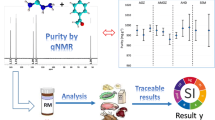Abstract
Quantitative nuclear magnetic resonance (QNMR) is a primary analytical method which allows the use of a standard not directly related to the target analyte. This could allow the introduction of a single universal reference material (URM) to which all other organic standard reference materials/certified reference materials may be compared. Dimethylsulfone is a simple substance that fulfils all criteria necessary as the URM to which the QNMR analysis of all other organic substances may be referenced and hence we propose this as a candidate for this purpose.



Similar content being viewed by others
References
Pauli GF (2001) Phytochem Anal 12:28–42
Wells RJ, Cheung J (2001) Quantitative analysis of technical grade agrochemicals by high field 1H NMR spectroscopy. The Chemistry Preprint Server CPS:analchem/0103002
Wells RJ, Hook JM, Al-Deen TS, Hibbert DB (2002) J Agric Food Chem 50:3366–3374
Kasler F (1973) Quantitative analysis by NMR spectroscopy. Academic, London; Rackham DM (1976) Talanta 23:269–274
Rabenstein D, Keire DA (1991) Quantitative chemical analysis by NMR. In: Popov AI, Hallenga K (eds) Modern NMR techniques and their application in chemistry, vol. 11. Dekker, New York, pp 323–369
Holzgrabe U, Diehl BWK, Wawer I (1998) J Pharm Biomed Anal 17:557–616
Jancke H (1998) NMR spectroscopy as a primary analytical method. CCQM Rep 98(2):1–12
Al-Deen TS, Hibbert DB, Hook JM, Wells RJ (2002) Anal Chim Acta 474:125–135
Maniara G, Rajamoorthi K, Rajanand S, Stockton GW (1998) Anal Chem 70:4921–4928 [and references cited therein]
Jones C, Lemercinier X (2002)J Pharm Biomed Anal 30:1233–1247
Forshed J, Andersson FO, Jacobsson SP (2002)J Pharm Biomed Anal 29:495–505
Meusinger R (1999) Anal Chim Acta 391:277–288
Griffiths L, Irvine AM (1998) Analyst 123:1061–1068
Clarke D (1997) J Chem Ed 74:1464–1465
Larive CK, Jayawickrama D, Orfi L (1991) Appl Spectros 51:1531
Henderson TJ (2002) Anal Chem 74:191–198
Spyros A, Dais P (2000) J Agric Food Chem 48:802–805
Gard DR, Burquin JC, Gard JK (1992) Anal Chem 64:557–561
Slahck SC (1990) J Assoc Off Anal Chem 73:638–640
Lenz EM, Wilson ID, Wright B, Partridge EA, Rodgers CT, Haycock PR, Lindon JC, Nicholson JK (2002) J Pharm Biomed Anal 28:31–43
Navratliova H (2001) Magn Reson Chem 39:727–730
Ahvazi BC, Crestini C, Argyropoulos DS (1999) J Agric Food Chem 47:190–201
Adzes HT, Peters GJ, Noordhuis P, Vermorken JB (1993) Anal Biochem 214:25–30
Vlahov G, Schiavone C, Simone N (2001) Magn Reson Chem 39:689–695
Xia Z, Akim LG, Argyropoulos DS (2001) J Agric Food Chem 49:3573–3578
Lefevre JW, Silveira A (2000) J Chem Ed 77:83–85 [and references cited therein]
Lonnon DG, Hook JM (2003) Anal Chem 75:4659–4666
Derome AE (1989) Modern NMR techniques for chemistry research. Pergamon, New York, pp 168–172
Sanders JKM, Hunter BK (1990) Modern NMR spectroscopy: a guide for chemists, Chap. 3., Oxford University Press, Oxford, pp 61–65
Saed Al-Deen T, Hibbert DB, Hook JM, Wells RJ (2004) Accred Qual Assur 9: 55–63
Harris RK, Mann BE (eds) (1976) QNMR and the periodic table. Academic, London
Acknowledgements
We wish to thank Dr. G. Ball for fruitful discussions, Mrs H. Stender for expert assistance obtaining NMR spectra, Dr. L. Besley of the Australian National Measurement Laboratory for the measurements of DMSO2 by DSC and Prof. D.B. Hibbert for statistical advice.
Author information
Authors and Affiliations
Corresponding author
Rights and permissions
About this article
Cite this article
Wells, R.J., Cheung, J. & Hook, J.M. Dimethylsulfone as a universal standard for analysis of organics by QNMR. Accred Qual Assur 9, 450–456 (2004). https://doi.org/10.1007/s00769-004-0779-0
Received:
Accepted:
Published:
Issue Date:
DOI: https://doi.org/10.1007/s00769-004-0779-0




